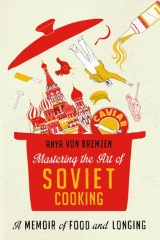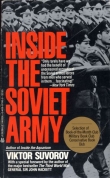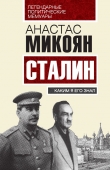
Текст книги "Mastering the Art of Soviet Cooking"
Автор книги: Anya von Bremzen
Жанры:
Биографии и мемуары
,сообщить о нарушении
Текущая страница: 1 (всего у книги 23 страниц)
Anya von Bremzen
MASTERING THE ART OF SOVIET COOKING
A Memoir of Food and Longing
For Larisa
PROLOGUE
POISONED MADELEINES
Whenever my mother and I cook together, she tells me her dreams. So rich and intense is Mom’s dream life, she’s given to cataloging and historicizing it: brooding black-and-white visions from her Stalinist childhood; sleek cold war thrillers laced with KGB spooks; melodramas starring duty-crushed lovers.
In a nod, I suppose, to her Iron Curtain past, Mother gets trapped in a lot of her dreams—although now, at seventy-nine years of age and after nearly four American decades, she tends to get trapped in pretty cool places. Deep, for example, in a mazelike, art-filled palace, one much resembling the Metropolitan Museum of Art, where, having retired as a schoolteacher, she works as a docent. In this dream’s Technicolor finale, an orange balloon rescues Mom from her labyrinth and deposits her at the museum’s sumptuous café. Whereupon she gorges on cream puffs.
But it’s one dream of hers from long ago, one I remember her telling me of many times, that’s most emblematic. Here she is, skinny, short-haired, tiptoeing into my bedroom as I awake to the hopeless darkness of a Soviet socialist winter. We’re in our minuscule flat in a shoddy Khrushchev-issue stained-concrete prefab on the outskirts of Moscow. It’s 1968; I am five. Soviet tanks have just rolled into Prague, my dad has abandoned us recently, and we’ve moved here from a Kafka-esque communal apartment near the Kremlin where eighteen families shared one kitchen. Mom, in her robe with faded blue cornflowers, sits on my bed, presses a reassuring kiss to my forehead. But in her eyes I see such toska (that peculiarly Russian ache of the soul), such desperate longing, I know right away she’s been visited once more by that dream.
“Listen, listen, Anyuta,” she murmurs. “Yet again I’m transformed into a lastochka (a swallow)… I escape from Russia, flying across the Soviet border, and somehow no one asks me for documents. And suddenly I’m in Paris! In Paris! I circle over the ocher-colored streets, I recognize them from Utrillo paintings. On a tiny rue—it’s called ‘Street of a Cat Who Fishes’—I notice an enchanting café. I speed down to the impossibly colorful awning, I’m dizzy from the delicious smell of the food, everything inside me is aching to taste it, to join the people inside…”
At this point my mother always woke up. Always on the wrong side of the entrance. Always ravenous, overwhelmed by yearning for a world beyond the border she was never destined to see. By nostalgia for flavors that would forever elude her.
All happy food memories are alike; all unhappy food memories are unhappy after their own fashion.
Mom and I both grew up within a triumphalist, scarlet-blazed fairy tale of socialist abundance and glorious harvests. Our experiences, though, featured no happy kitchens enveloped in an idyllic haze of vanilla, no kindly matriarchs setting golden holiday roasts on the table. Tea cakes rich in bourgeois butter? I do have such a memory… It’s of Mom reading Proust aloud in our Khrushchevian slum; me utterly bored by the Frenchman’s sensory reveries but besotted with the idea of the real, edible cookie. What did it taste like, that exotic capitalist madeleine? I desperately wanted to know.
Inevitably, a story about Soviet food is a chronicle of longing, of unrequited desire. So what happens when some of your most intense culinary memories involve foods you hadn’t actually tasted? Memories of imaginings, of received histories; feverish collective yearning produced by seventy years of geopolitical isolation and scarcity…
Until recently I didn’t talk about such memories much. Asked why I write about food, I’d just rattle off my well-rehearsed story. How my mother and I emigrated from Moscow without my father in 1974—stateless refugees with no winter coats and no right of return. How, after I graduated from Juilliard, my piano career was cut short in the late eighties by a wrist injury. And how, searching for a new start, I fell into food, almost by accident, really. And I never looked back. Following my first cookbook, Please to the Table, about the cuisines of the former USSR, nice things kept happening: exciting magazine stories, more cookbooks, awards, almost two decades of travel and memorable meals.
Here’s what I rarely mentioned: scribbled skull-and-bones warnings affixed to pots in my grandmother’s communal apartment kitchen, where comrade residents pilfered one another’s soup meat. The afternoons of me desperately gagging on caviar at my kindergarten for the offspring of the Central Committee—gagging because along with the elite Party fish eggs I felt I was ingesting the very ideology my anti-Soviet mom couldn’t stomach. Nor did I mention the girls’ bathroom at School 110, where I, a nine-year-old fledgling black marketeer in a scratchy brown uniform, charged my Soviet classmates five kopeks to touch the bottle of Coca-Cola that friends had brought us from the mythical zagranitsa (abroad). Nor my present-day impulse to steal every last croissant from the splendid free breakfast buffets at the lovely hotels where I often stay for my work.
What would be the point of confessing my constant feeling of inhabiting two parallel food universes: one where degustation menus at places like Per Se or Noma are routine; the other where a simple banana—a once-a-year treat back in the USSR—still holds an almost talismanic sway over my psyche?
The stories I’ve kept to myself are the stuff of this book. Ultimately, they’re why I really write about food. But they aren’t just my stories. For any ex-citizen of a three-hundred-million-strong Soviet superpower, food is never a mere individual matter. In 1917 bread riots sparked the overthrow of the czar, and, seventy-four years later, catastrophic food shortages helped push Gorbachev’s floundering empire into the dustbin. In between, seven million people perished from hunger during Stalin’s collectivization; four million more starved to death during Hitler’s war. Even in calmer times, under Khrushchev and Brezhnev, the daily drama of putting a meal on the table trumped most other concerns. Across eleven time zones the collective socialist fate of standing in food lines united comrades from the Union’s fifteen ethnic republics. Food was an abiding theme of Soviet political history, permeating every nook and cranny of our collective unconscious. Food brought us together in obsessive Soviet hospitality rituals—more herring, more Doctor’s Kolbasa—and in our shared envy and spite for the privileged few, the grifters and Party hacks with their access to better kolbasa (sausage). Food anchored the domestic realities of our totalitarian state, supplying a shimmer of desire to a life that was mostly drab, sometimes absurdly comical, on occasion unbearably tragic, but just as often naively optimistic and joyous. Food, as one academic has noted, defined how Russians endured the present, imagined the future, and connected to their past.
That past is now gone. Vanished after the Soviet Union’s collapse. In place of our “Socialist Homeland” there are cultural ruins, a vast archaeological site of a Soviet Atlantis. But we’re not ready to let go of this rubble. Toppled headless statues of leaders, songbooks and candy wrappers, once-scarlet Young Pioneer scarves, triangular Soviet milk cartons blackened with grime—we cling to these fragments. Unlike the melancholy ruins that fueled the Romantics’ nostalgia for an idealized past, ours are pieces of our physical homes, of the lives we once lived. For us they’re still freighted with meaning: historical, political, personal. And almost always ambiguous.
I started my own collection of socialist fragments in 1974, weeks into our Philadelphia life. Mom instantly fell for Amerika. Me? Huddled on our bony refugee sofa I read Chekhov’s Three Sisters and whimpered along with the characters: “To Moscow… to Moscow.” My childhood fantasies of capitalist delicacies crashed against our first meal at the Robin Hood Diner. I choked on the cloying fluff of American coleslaw, stared in shock at the Day-Glo that is Velveeta. At home, while my mother gleefully slapped Oscar Mayer bologna onto alien Wonder Bread, I pined for the fragrant bricks of Moscow sourdough rye and the stale reek of cheapo Krakovskaya kolbasa. I’m pretty sure I’d lost my sense of taste those first Philadelphia months. Because depleted of political pathos, hospitality, that heroic aura of scarcity, food didn’t seem much of anything anymore.
Like a raggedy orphan, I paced our apartment, repeating to myself our sardonic Soviet defitsit (shortage) jokes. “Would you slice one hundred grams of kolbasa?” asks a man in a store. “Bring the kolbasa and we’ll slice,” answers the salesgirl. Or “Why are you emigrating?” “Coz I’m sick of celebrations,” says the Jew. “Bought toilet paper—celebration; bought kolbasa—more celebrating.”
In Philadelphia, no one celebrated Oscar Mayer bologna.
To revive my taste buds I began playing a game in my head. Picturing myself at a dacha (country cottage) surrounded by prickly gooseberry shrubs, I’d mentally preserve and pickle the tastes and smells of my Soviet socialist past in an imaginary three-liter jar of memory. In went the Order of Lenin Red October chocolate bars with a mirthful kid on the wrapper. In went the scarlet-wrapped Bolshevik Factory Jubilee Biscuits, the ones that dissolved so poignantly when dipped in tea from a yellow packet adorned with an elephant. In my mind’s eye I unwrapped the foil from the squishy rectangles of Friendship Cheese. Paused to dig an imaginary aluminum fork into the industrial breading of the six-kopek meat patties named after Stalin’s food supply commissar.
There was, however, an ideological cloud darkening my nostalgia exercise. The Friendship Cheese, the kolbasa, the chocolates—all were produced by the reviled Party-state we’d fled. Recalling Mom’s Proust recitations, I’ve come up with a phrase to describe them. Poisoned madeleines.
This is my “poisoned madeleine” memoir. It was my mother, my frequent co-conspirator in the kitchen and my conduit to our past, who suggested the means to convey this epic disjunction, this unruly collision of collectivist myths and personal antimyths. We would reconstruct every decade of Soviet history—from the prequel 1910s to the postscript present day—through the prism of food. Together, we’d embark on a yearlong journey unlike any other: eating and cooking our way through decade after decade of Soviet life, using her kitchen and dining room as a time machine and an incubator of memories. Memories of wartime rationing cards and grotesque shared kitchens in communal apartments. Of Lenin’s bloody grain requisitioning and Stalin’s table manners. Of Khrushchev’s kitchen debates and Gorbachev’s disastrous antialcohol policies. Of food as the focal point of our everyday lives, and—despite all the deprivations and shortages—of compulsive hospitality and poignant, improbable feasts.
PART I
FEASTS, FAMINES, FABLES

My maternal grandparents, Lisa and Naum Frumkin, circa 1929
CHAPTER ONE

1910s: THE LAST DAYS OF THE CZARS
My mother is expecting guests.
In just a few hours in this sweltering July heat wave, eight people will show up for an extravagant czarist-era dinner at her small Queens apartment. But her kitchen resembles a building site. Pots tower and teeter in the sink; the food processor and blender drone on in unison. In a shiny bowl on Mom’s green faux-granite counter, a porous blob of yeast dough seems weirdly alive. I’m pretty sure it’s breathing. Unfazed, Mother simultaneously blends, sautés, keeps an eye on Chris Matthews on MSNBC, and chatters away on her cordless phone. At this moment she suggests a plump modern-day elf, multitasking away in her orange Indian housedress.
Ever since I can remember, my mother has cooked like this, phone tucked under her chin. Of course, back in Brezhnev’s Moscow in the seventies when I was a kid, the idea of an “extravagant czarist dinner” would have provoked sardonic laughter. And the cord of our antediluvian black Soviet telefon was so traitorously twisted, I once tripped on it while carrying a platter of Mom’s lamb pilaf to the low three-legged table in the cluttered space where my parents did their living, sleeping, and entertaining.
Right now, as one of Mom’s ancient émigré friends fills her ear with cultural gossip, that pilaf episode returns to me in cinematic slow motion. Masses of yellow rice cascade onto our Armenian carpet. Biddy, my two-month-old puppy, greedily laps up every grain, her eyes and tongue swelling shockingly in an instant allergic reaction to lamb fat. I howl, fearing for Biddy’s life. My father berates Mom for her phone habits.
Mom managed to rescue the disaster with her usual flair, dotty and determined. By the time guests arrived—with an extra four non-sober comrades—she’d conjured up a tasty fantasia from two pounds of the proletarian wurst called sosiski. These she’d cut into petal-like shapes, splayed in a skillet, and fried up with eggs. Her creation landed at table under provocative blood-red squiggles of ketchup, that decadent capitalist condiment. For dessert: Mom’s equally spontaneous apple cake. “Guest-at-the-doorstep apple charlotte,” she dubbed it.
Guests! They never stopped crowding Mom’s doorstep, whether at our apartment in the center of Moscow or at the boxy immigrant dwelling in Philadelphia where she and I landed in 1974. Guests overrun her current home in New York, squatting for weeks, eating her out of the house, borrowing money and books. Every so often I Google “compulsive hospitality syndrome.” But there’s no cure. Not for Mom the old Russian adage “An uninvited guest is worse than an invading Tatar.” Her parents’ house was just like this, her sister’s even more so.
Tonight’s dinner, however, is different. It will mark our archival adieu to classic Russian cuisine. For such an important occasion Mom has agreed to keep the invitees to just eight after I slyly quoted a line from a Roman scholar and satirist: “The number of dinner guests should be more than the Graces and less than the Muses.” Mom’s quasi-religious respect for culture trumps even her passion for guests. Who is she to disagree with the ancients?
And so, on this diabolically torrid late afternoon in Queens, the two of us are sweating over a decadent feast set in the imagined 1910s—Russia’s Silver Age, artistically speaking. The evening will mark our hail and farewell to a grandiose decade of Moscow gastronomy. To a food culture that flourished at the start of the twentieth century and disappeared abruptly when the 1917 revolution transformed Russian cuisine and culture into Soviet cuisine and culture—the only version we knew.
Mom and I have not taken the occasion lightly.
The horseradish and lemon vodkas that I’ve been steeping for days are chilling in their cut-crystal carafes. The caviar glistens. We’ve even gone to the absurd trouble of brewing our own kvass, a folkloric beverage from fermented black bread that’s these days mostly just mass-produced fizz. Who knows? Besides communing with our ancestral stomachs, this might be our last chance on this culinary journey to eat really well.
“The burbot liver—what to do about the burbot liver?” Mom laments, finally off the phone.
Noticing how poignantly scratched her knuckles are from assorted gratings, I reply, for the umpteenth time, that burbot, noble member of the freshwater cod family so fetishized by pre-revolutionary Russian gourmands, is nowhere to be had in Jackson Heights, Queens. Frustrated sighing. As always, my pragmatism interferes with Mom’s dreaming and scheming. And let’s not even mention viziga, the desiccated dorsal cord of a sturgeon. Burbot liver was the czarist foie gras, viziga its shark’s fin. Chances of finding either in any zip code hereabouts? Not slim—none.
But still, we’ve made progress.
Several test runs for crispy brains in brown butter have yielded smashing results. And despite the state of Mom’s kitchen, and the homey, crepuscular clutter of her book-laden apartment, her dining table is a thing of great beauty. Crystal goblets preen on the floral, antique-looking tablecloth. Pale blue hydrangeas in an art nouveau pitcher I found at a flea market in Buenos Aires bestow a subtle fin-de-siècle opulence.
I unpack the cargo of plastic containers and bottles I’ve lugged over from my house two blocks away. Since Mom’s galley kitchen is far too small for two cooks, much smaller than an aristocrat’s broom closet, I’ve already brewed the kvass and prepared the trimmings for an anachronistic chilled fish and greens soup called botvinya. I was also designated steeper of vodkas and executer of Guriev kasha, a dessert loaded with deep historical meaning and a whole pound of home-candied nuts. Mom has taken charge of the main course and the array of zakuski, or appetizers.
A look at the clock and she gasps. “The kulebiaka dough! Check it!”
I check it. Still rising, still bubbling. I give it a bang to deflate—and the tang of fermenting yeast tickles my nostrils, evoking a fleeting collective memory. Or a memory of a received memory. I pinch off a piece of dough and hand it to Mom to assess. She gives me a shrug as if to say, “You’re the cookbook writer.”
But I’m glad I let her take charge of the kulebiaka. This extravagant Russian fish pie, this history lesson in a pastry case, will be the pièce de résistance of our banquet tonight.
“The kulebiaka must make your mouth water, it must lie before you, naked, shameless, a temptation. You wink at it, you cut off a sizeable slice, and you let your fingers just play over it…. You eat it, the butter drips from it like tears, and the filling is fat, juicy, rich with eggs, giblets, onions…”
So waxed Anton Pavlovich Chekhov in his little fiction “The Siren,” which Mom and I have been salivating over during our preparations, just as we first did back in our unglorious socialist pasts. It wasn’t only us Soviet-born who fixated on food. Chekhov’s satiric encomium to outsize Slavic appetite is a lover’s rapturous fantasy. Sometimes it seems that for nineteenth-century Russian writers, food was what landscape (or maybe class?) was for the English. Or war for the Germans, love for the French—a subject encompassing the great themes of comedy, tragedy, ecstasy, and doom. Or perhaps, as the contemporary author Tatyana Tolstaya suggests, the “orgiastic gorging” of Russian authors was a compensation for literary taboos on eroticism. One must note, too, alas, Russian writers’ peculiarly Russian propensity for moralizing. Rosy hams, amber fish broths, blini as plump as “the shoulder of a merchant’s daughter” (Chekhov again), such literary deliciousness often serves an ulterior agenda of exposing gluttons as spiritually bankrupt philistines—or lethargic losers such as the alpha glutton Oblomov. Is this a moral trap? I keep asking myself. Are we enticed to salivate at these lines so we’ll end up feeling guilty?
But it’s hard not to salivate. Chekhov, Pushkin, Tolstoy—they all devote some of their most fetching pages to the gastronomical. As for Mom’s beloved Nikolai Gogol, the author of Dead Souls anointed the stomach the body’s “most noble” organ. Besotted with eating both on and off the page—sour cherry dumplings from his Ukrainian childhood, pastas from his sojourns in Rome—scrawny Gogol could polish off a gargantuan dinner and start right in again. While traveling he sometimes even churned his own butter. “The belly is the belle of his stories, the nose is their beau,” declared Nabokov. In 1852, just short of his forty-third birthday, in the throes of religious mania and gastrointestinal torments, Nikolai Vasilievich committed a slow suicide rich in Gogolian irony: he refused to eat. Yes, a complicated, even tortured, relationship with food has long been a hallmark of our national character.
According to one scholarly count, no less than eighty-six kinds of edibles appear in Dead Souls, Gogol’s chronicle of a grifter’s circuit from dinner to dinner in the vast Russian countryside. Despairing over not being able to scale the heights of the novel’s first volume, poor wretched Gogol burned most of the second. What survives includes the most famous literary ode to kulebiaka—replete with a virtual recipe.
“Make a four-cornered kulebiaka,” instructs Petukh, a spiritually bankrupt glutton who made it through the flames. And then:
“In one corner put the cheeks and dried spine of a sturgeon, in another put some buckwheat, and some mushrooms and onion, and some soft fish roe, and brains, and something else as well…. As for the underneath… see that it’s baked so that it’s quite… well not done to the point of crumbling but so that it will melt in the mouth like snow and not make any crunching sound.
Petukh smacked his lips as he spoke.”
Generations of Russians have smacked their own lips at this passage. Historians, though, suspect that this chimerical “four-cornered” kulebiaka might have been a Gogolian fiction. So what then of the genuine article, which is normally oblong and layered?
To telescope quickly: kulebiaka descends from the archaic Slavic pirog (filled pie). Humbly born, they say, in the 1600s, it had by its turn-of-the-twentieth-century heyday evolved into a regal golden-brown case fancifully decorated with cut-out designs. Concealed within: aromatic layers of fish and viziga, a cornucopia of forest-picked mushrooms, and butter-splashed buckwheat or rice, all the tiers separated by thin crepes called blinchiki—to soak up the juices.
Mom and I argued over every other dish on our menu. But on this we agreed: without kulebiaka, there could be no proper Silver Age Moscow repast.
When my mother, Larisa (Lara, Larochka) Frumkina—Frumkin in English—was growing up in the 1930s high Stalinist Moscow, the idea of a decadent czarist-era banquet constituted exactly what it would in the Brezhnevian seventies: laughable blue cheese from the moon. Sosiski were Mom’s favorite food. I was hooked on them too, though Mom claims that the sosiski of my childhood couldn’t hold a candle to the juicy Stalinist article. Why do these proletarian franks remain the madeleine of every Homo sovieticus? Because besides sosiski with canned peas and kotleti (minced meat patties) with kasha, cabbage-intensive soups, mayo-laden salads, and watery fruit kompot for dessert—there wasn’t all that much to eat in the Land of the Soviets.
Unless, of course, you were privileged. In our joyous classless society, this all-important matter of privilege has nagged at me since my early childhood.
I first glimpsed—or rather heard—the world of privileged food consumption during my first three years of life, at the grotesque communal Moscow apartment into which I was born in 1963. The apartment sat so close to the Kremlin, we could practically hear the midnight chimes of the giant clock on the Spassky Tower. There was another sound too, keeping us up: the roaring BLARGHHH of our neighbor Misha puking his guts out. Misha, you see, was a food store manager with a proprietary attitude toward the socialist food supply, likely a black market millionaire who shared our communal lair only for fear that flaunting his wealth would attract the unwanted attention of the anti-embezzlement authorities. Misha and Musya, his blond, big-bosomed wife, lived out a Mature Socialist version of bygone decadence. Night after night they dined out at Moscow’s few proper restaurants (accessible to party bigwigs, foreigners, and comrades with illegal rubles), dropping the equivalent of Mom’s monthly salary on meals that Misha couldn’t even keep in his stomach.
When the pair stayed home, they ate unspeakable delicacies—batter-fried chicken tenders, for instance—prepared for them by the loving hands of Musya’s mom, Baba Mila, she a blubbery former peasant with one eye, four—or was it six?—gold front teeth, and a healthy contempt for the nonprivileged.
“So, making kotleti today,” Mila would say in the kitchen we all shared, fixing her monocular gaze on the misshapen patties in Mom’s chipped aluminum skillet. “Muuuuusya!” she’d holler to her daughter. “Larisa’s making kotleti!”
“Good appetite, Larochka!” (Musya was fond of my mom.)
“Muuusya! Would you eat kotleti?”
“Me? Never!”
“Aha! You see?” And Mila would wag a swollen finger at Mom.
One day my tiny underfed mom couldn’t restrain herself. Back from work, tired and ravenous, she pilfered a chicken nugget from a tray Mila had left in the kitchen. The next day I watched as, red-faced and teary-eyed, she knocked on Misha’s door to confess her theft.
“The chicken?” cackled Mila, and I still recall being struck by how her twenty-four-karat mouth glinted in the dim hall light. “Help yourself anytime—we dump that shit anyway.”
And so it was that about once a week we got to eat shit destined for the economic criminal’s garbage. To us, it tasted pretty ambrosial.
In 1970, into the eleventh year of their on-and-off marriage, my parents got back together after a four-year separation and we moved to an apartment in the Arbat. And kulebiaka entered my life. Here, in Moscow’s most aristocratic old neighborhood, I was shooed out of the house to buy the pie in its Soviet incarnation at the take-out store attached to Praga, a restaurant famed “before historical materialism” (that’s ironic Sovietese for “distant past”) for its plate-size rasstegai pies with two fillings: sturgeon and sterlet.
Even in the dog days of Brezhnev, Praga was fairly dripping with klass—a fancy restoran where Misha types groped peroxide blondes while a band blasted, and third-world diplomats hosted receptions in a series of ornate private rooms.
“Car of Angola’s ambassador to the door!”
This was music to my seven-year-old ears.
If I loitered outside Praga intently enough, if my young smile and “Khello, khau yoo laik Moskou?” were sufficiently charming, a friendly diplomat might toss me a five-pack of Juicy Fruit. The next day, in the girls’ bathroom, aided by ruler and penknife, I would sell off the gum, millimeter by millimeter, to favored classmates. Even a chewed-up blob of Juicy Fruit had some value, say a kopek or two, as long as you didn’t masticate more than five times, leaving some of that floral Wrigley magic for the next masticator to savor. Our teacher’s grave warnings that sharing capitalist gum causes syphilis only added to the illegal thrill of it all.
I loved everything about shopping at Praga. Loved skipping over the surges of brown melted snow and sawdust that comrade janitors gleefully swept right over the customers’ feet. Loved inhaling the signature scent of stale pork fat, peregar (hangover breath), and the sickly sweet top notes of Red Moscow perfume. Loved Tyotya Grusha (Aunt Pear), Praga’s potato-nosed saleslady, clacking away on her abacus with savage force. Once, guided by some profound late socialist instinct, I shared with Grusha a five-pack of Juicy Fruit. She snatched it without even a thank-you, but from then on she always made sure to reserve a kulebiaka for me. “Here, you loudmouthed infection,” she’d say, also slipping me a slab of raisin-studded poundcake under the counter.
And this is how I came to appreciate the importance of black marketeering, blat (connections), and bribery. I was now inching my own way toward privilege.
Wearing shiny black rubber galoshes over my valenki (felt boots) and a coat made of “mouse fur” (in the words of my dad), I toted the Pravda-wrapped kulebiaka back to our family table, usually taking the long way home—past onion-domed churches now serving as warehouses, past gracious cream and green neoclassical facades scrawled with the unprintable slang that Russians call mat. I felt like Moscow belonged to me on those walks; along its frozen streetscape I was a flaneur flush with illicit cash. On Kalinin Prospect, the modernist grand boulevard that dissected the old neighborhood, I’d pull off my mittens in the unbearable cold to count out twenty icy kopeks for the blue-coated lady with her frosty zinc ice cream box. It was almost violent, the shock of pain on my teeth as I sank them into the waffle cup of vanilla plombir with a cream rosette, its concrete-like hardness defying the flat wooden scooping spoon. Left of Praga, the Arbatskaya metro station rose, star-shaped and maroon and art deco, harboring its squad of clunky gray gazirovka (soda) machines. One kopek for unflavored; three kopeks for a squirt of aromatic thick yellow syrup. Scoring the soda: a matter of anxious uncertainty. Not because soda or syrup ran out, but because alkogoliks were forever stealing the twelve-sided beveled drinking glass—that Soviet domestic icon. If, miraculously, the drunks had left the glass behind, I thrilled in pressing it hard upside down on the machine’s slatted tray to watch the powerful water jet rinse the glass of alcoholic saliva. Who even needed the soda?
Deeper into Old Arbat, at the Konservi store with its friezes of socialist fruit cornucopias, I’d pause for my ritual twelve-kopek glass of sugary birch-tree juice dispensed from conical vintage glass vats with spigots. Then, sucking on a dirty icicle, I’d just wander off on a whim, lost in a delta of narrow side streets that weaved and twisted like braids, each bearing a name of the trade it once supported: Tablecloth Lane, Bread Alley. Back then, before capitalism disfigured Moscow’s old center with billboards and neons and antihistorical historicist mansions, some Arbat streets did retain a certain nineteenth-century purity.
At home I usually found Mom in the kitchen, big black receiver under her chin, cooking while discussing a new play or a book with a girlfriend. Dad struck a languid Oblomovian pose on the couch, playing cards with himself, sipping cold tea from his orange cup with white polka-dots.
“And how was your walk?” Mother always wanted to know. “Did you remember to stop by the house on Povarskaya Street where Natasha from War and Peace lived?” At the mention of Tolstoy, the Juicy Fruit in my pocket would congeal into a guilty yellow lump on my conscience. Natasha Rostova and my mom—they were so poetic, so gullible. And I? What was I but a crass mini-Misha? Dad usually came to the rescue: “So, let’s have the kulebiaka. Or did Praga run out?” For me, I wanted to reply, Praga never runs out! But it seemed wise not to boast of my special blat with Aunt Grusha, the saleslady, in the presence of my sweet innocent mother.











